Understand and Develop Team Culture with DiSC®
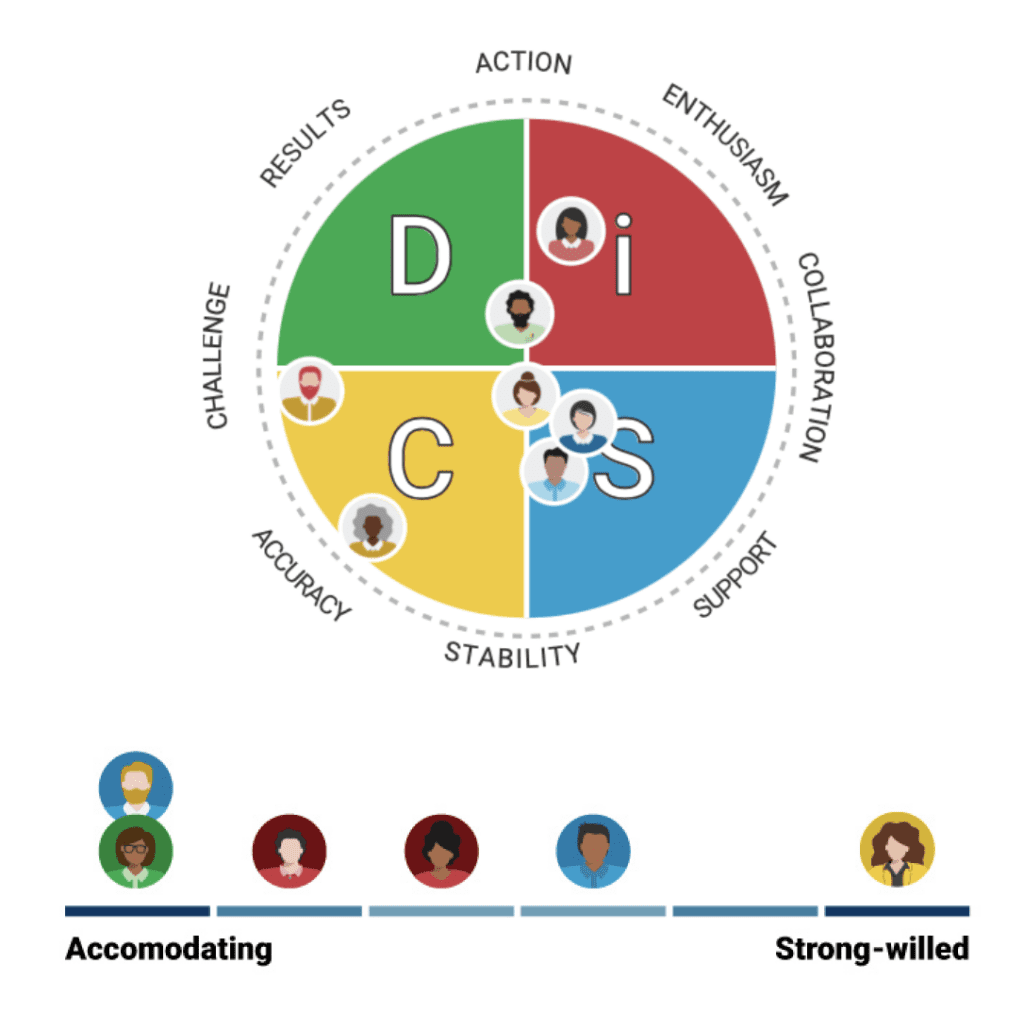
Team Culture & DiSC
Team culture refers to the shared values, beliefs, attitudes, and behaviors that shape the environment within a team.
It encompasses the unwritten rules that guide how team members communicate and work toward achieving common goals. Team culture also influences how individual members perceive their roles, responsibilities, and relationships, and it can have a significant impact on team performance.
A positive team culture fosters trust, respect, and open communication among team members. It encourages collaboration, innovation, and diversity of thought.
Alternatively, a negative team culture results in poor communication, lack of trust, limited collaboration, and unhealthy competition among team members.
Fortunately, there is a model called DiSC® that can help teams understand their team culture.
It won’t identify if your team has a negative or positive team culture, but it will provide insights into the makeup of the team’s culture. This model can help individual members decipher the unwritten rules of their team. It can also allow team leaders to navigate ways to improve culture.
In this article, we will review how to understand and build a team culture using Everything DiSC® Catalyst. You will learn the following:
Throughout this article, I will show how our team has used DiSC to help understand our own team culture.
As a small, remote team, we face similar challenges to what many teams face. No matter the current culture of your team, DiSC can provide valuable insights and perspectives that will help any team become more effective.
We know it has helped us.
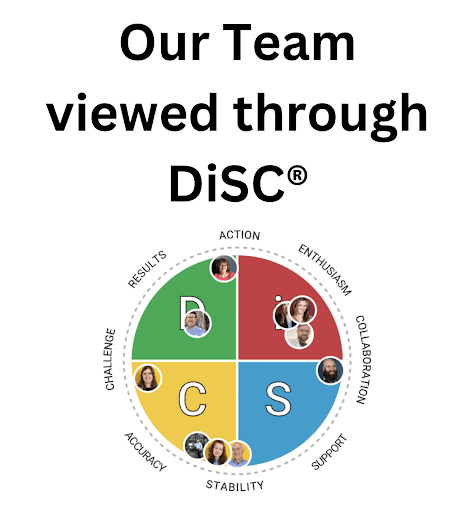
Describe and identify team culture with DiSC®
One of the first noticeable traits of any team or group is the level of energy that is present.
There are highly effective teams that are loud and boisterous and other successful teams that work quietly independently, only interacting when necessary.
How can one team’s culture act like they are working at a bar or restaurant and another work like they are in a library?
Team Culture and Energy
Everything DiSC® accurately measures the ‘energy’ of a group because it is one of the primary measurement scales used to determine a person’s personality when they take a DiSC Workplace Assessment.
DiSC measures the introverted and extroverted scale, which is also identified on the Big Five Personality traits and MBTI/Myers-Briggs.

However, Everything DiSC doesn’t use the terms introvert and extrovert to describe a person’s style or team’s culture because while this trait is identifiable through assessment, it doesn’t encompass the full perspective that the DiSC Model offers.
A person with a C Personality Type would also identify as being precise, accurate, logical, and seeking stability beyond identifying that they have an introverted personality style. Similarly, a team comprising of C-Style individuals likely has a C Culture where they reward accuracy, attention to detail, and dependability. The team atmosphere is likely quiet as well.
These insights and concepts are measured within two scales on the DiSC model.
The first dimension measures ‘energy,’ and it creates the horizontal axis of the DiSC model:
Teams that are comprised of individuals who complete the DiSC Workplace assessment and have a dot that lives in the ‘Active’ part of the DiSC map are likely going to be more dynamic and quick to action and might create a work environment that is more lively than their peers in the bottom half of the map may prefer.
Individuals whose style is in the bottom half of the map likely prefer to have fewer interruptions in their day and seek a more stable and calm work environment.
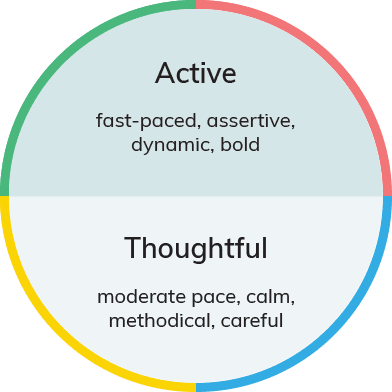
Team Culture and Skepticism
The second dimension of the DiSC Model also measures whether a person is more questioning or accepting as it relates to how they view their environment:
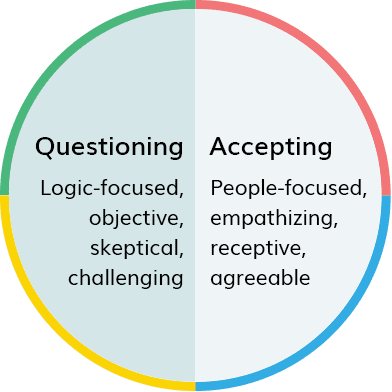
Regarding team culture, this could mean a team demands more time to research a particular strategy or directive if they have more individuals on the questioning side of the map.
These teams may come across as aggressive or pushy compared to teams who have more members that are accepting and agreeable.
Teams with individuals on the accepting side aren’t pushovers. They are just more receptive to new ideas. They also place a higher emphasis on teamwork rather than individual accomplishments.
Team Culture and the Four DiSC Styles
While the two dimensions provide many insights about team culture, it’s important to know its makeup based on four DiSC behavioral styles. An individual’s personality style is based on combining the two dimensions. Below is a list of the four styles with the combination of the two aforementioned dimensions.
- D-Style (Active + Questioning)
- i-Style (Active + Accepting)
- S-Style (Thoughtful + Accepting)
- C-Style (Thoughtful + Questioning)
These four styles are produced as an output when an individual finishes the full assessment based on the previously mentioned two dimensions. Teams that contain a majority of one particular style often produce a culture that shares similar motivations and characteristics. However, the team leader’s style likely has a big influence on the team’s culture as well.
The team members’ DiSC styles each have their own preferences in terms of what’s important to them and what they will criticize:
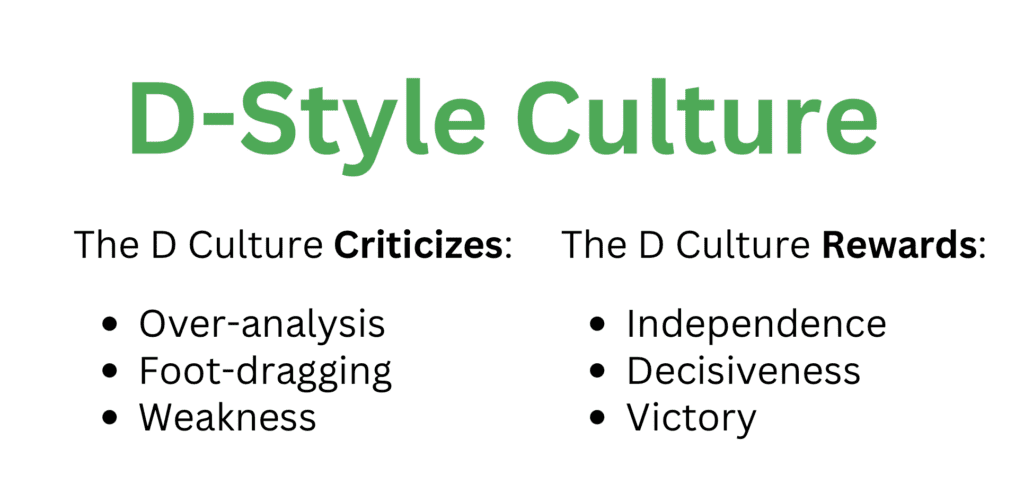
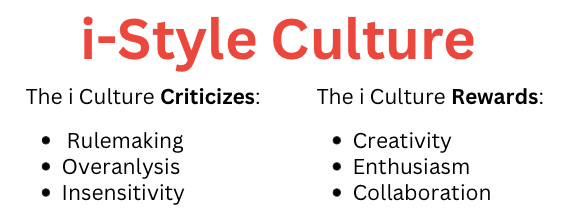
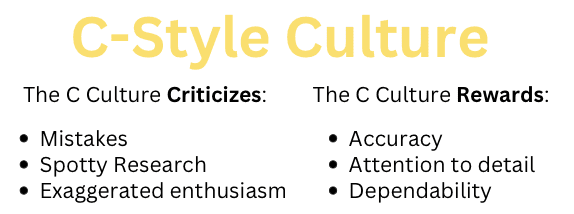
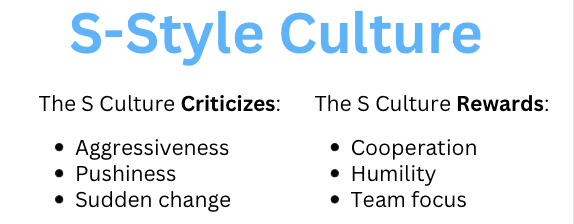
Team Tendencies based on DiSC
DiSC Catalyst offers additional insights into Team Culture based on the behavioral tendencies of the group. Catalyst offers showcases cultural insights based on 8 tendencies on a continuum:
- Accommodating – Strong-willed
- Private – Outgoing
- Focused on feelings – Focused on logic
- Tactful – Frank
- Structured – Unstructured
- Focused on realities – Focused on possibilities
- Skeptical – Accepting
- Fast-paced – Steady Paced
These tendencies are useful for teams to understand what hidden values they might not realize they hold. As an example, our team weighs heavily on the tendency “Focused on possibilities”:
This continuum showcases why our team may jump too quickly to a new idea, product, or strategy without really weighing the consequences.
We may drive the two individuals on our team who are focused on realistic outcomes insane!
The Team Leader(s)’s DiSC Style vs Team’s Style
One aspect of a team’s culture that should also be discussed is the team’s leadership style. Often, team communication issues can arise when a team’s style is out of sync with the leader’s style.
This concept is easy to understand from the perspective of a team meeting. Our team is pretty evenly dispersed on the continuum of Structured – Unstructured:

This would signal that we likely have a good balance between keeping and maintaining orderly meetings.
However, when you look at just our leadership team’s style, you will see we actually are a very unstructured group:

Over the past year, our team has grown, and our leadership team spends most of our leadership meetings discussing ways to build more structure for our team and provide processes to maintain communication as we all work remotely.
We recognize that this is a need for our team, and we work hard to provide it.
Use DiSC® to improve Team Culture
Teams that want to improve or understand their team culture can start by using DiSC to uncover unspoken norms, tendencies, and preferences on their team. The process requires that everyone on the team have access to Everything DiSC Workplace on Catalyst. Once each member has their report, teams can start discussing the below topics:
- Are one or more styles heavily represented? Is one style under-represented?
This question asks teams to identify if they behave like the majority style and if the minority style’s tendencies are respected or acknowledged. As an example, for teams that contain more D and i-Styles, are there checks in place to ensure work is completed accurately?
- What is the team leader’s style? Are there communication issues that arise from a disconnect between the team leader’s style and their team’s cultural style?
If a team leader has a C-Style, do they recognize that they may need to adapt their style to meet the communication needs of the rest of the team?
Here are a few other points that should be considered:
- What behaviors are rewarded by the team’s culture? Do they match the majority style or the team leader’s style?
- What behaviors are criticized by the team’s culture? Do they match the minority styles in the group?
To further continue this discussion, download the full Catalyst Groups Discussion Guide for a larger conversation about team culture.
Need help developing team culture?
Our organization is available to run virtual, two-hour team DiSC training sessions.
For $995 (assessments sold separately), we will review key concepts about DiSC with your team and provide a space for team members to engage in partner and small group discussions.


